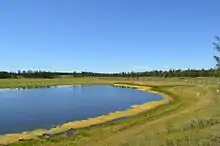Alas (geography)
Alas (Yakut: Алаас) is a shallow depression which occurs primarily in Yakutia, which is formed by subsidence of the Arctic permafrost owing to repeated melting and refreezing. An alas first develops as a shallow lake as melt water fills the depression. The lake eventually dries out and is replaced by grasses and other herbaceous vegetation.

Alas Mamykan near Mayya.
An alas is different from thermokarst depressions found elsewhere in the Arctic in that the lake is only temporary. Due to the aridity of Yakutia, the lake will dry up once the underlying ice has been depleted.
Alases are often used for pasturage for horses as well as hay-fields. They are common in the Central Yakutian Lowland. The largest alas in the world is Myuryu, located in Ust-Aldan District.[1]
See also
References
- Evolution of the Alas of Central Yakutia (in Russian)
- Troeva, E. I. (2010). The Far North: Plant Biodiversity and Ecology of Yakutia. Springer Verlag. p. 390. ISBN 978-90-481-3773-2.
This article is issued from Wikipedia. The text is licensed under Creative Commons - Attribution - Sharealike. Additional terms may apply for the media files.